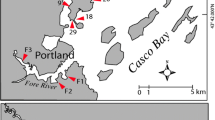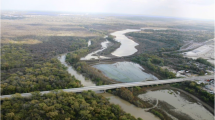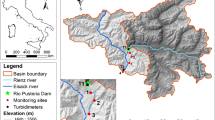Abstract
This study examined the effects of watershed development on macrobenthic communities in tidal creeks of Charleston Harbor, South Carolina, U.S. Two types of creeks were evaluated: upland creeks which drained watersheds consisting of at least 15% terrestrial land cover, and salt marsh creeks which drained no upland habitat (i.e., only intertidal habitat). Samples of macrobenthic organisms were taken along the longitudinal axis of twenty-three primary (first order) tidal creeks. Water and sediment quality data were also collected including measurements of dissolved oxygen, salinity, temperature, sediment characteristics, and toxic chemicals in the creek sediments. Hypoxic conditions occurred more than 15% of the time in both reference and developed creeks and were a natural attribute of these systems. The most severe and frequent hypoxia occurred in impacted salt marsh creeks. Salinity fluctuations were the greatest in developed upland creeks and salinity range was identified as a potentially reliable indicator of the degree to which watershed development has altered hydrodynamic processes. The creeks draining urban and industrial watersheds were degraded environments characterized by watersheds with high (>50%) levels of impervious surface, broad fluctuations in salinity, severe hypoxia, and potentially toxic levels of chemicals in the sediment. These creeks had low macrobenthic diversity and abundance and were numerically dominated by the oligochaeteMonopylephorus rubroniveus in mud sediments, and the polychaeteLaeoreis culveri in sand sediments. Suburban watersheds had 15–35% impervious surface and creeks draining them were exposed to frequent hypoxia and broad salinity fluctuations. The levels of chemical contaminants in sediments of suburban and impacted salt marsh creeks were generally not different from the levels in reference creeks. Macrobenthic diversity and abundance were higher for suburban and impacted salt marsh creeks than for urban and industrial creeks. However, suburban and salt marsh impacted creeks were numerically dominated by a few pollution indicative species including the oligochaetesM. rubroniveus andTubificoides brownae and the polychaeteL. culveri. These creeks appear to be exhibiting early signs of degradation (e.g., a simplified food web). Two promising community-level macrobenthic metrics for assessing environmental quality were identified: the proportional abundance of pollution indicative taxa, and the proportional abundance of pollution sensitive taxa. These indicators were significantly (p<0.05) correlated with the salinity range, the level of chemical contaminants in sediments, and amount of impervious surface in the watershed.
Similar content being viewed by others
Literature Cited
Anderson, J. R., E. E. Hardy, J. T. Roach, and R. E. Witmer. 1976. A Land Use and Land Cover Classification System for Use with Remote Sensor Data. U.S. Geological Survey Professional Paper 964. Reston, Virginia.
Arnold, C. L. andC. J. Gibbons. 1996. Impervious surface coverage.Journal of the American Planning Association 62:243–258.
Baca, B. J., J. Dingman, and T. E. Lankford. 1988. Evaluation of the impacts of dead-end canals and impoundments on an estuarine ecosystem, p. 201–212.In W. L. Lyke and T. J. Hoban (eds.), Proceedings of the Symposium on Coastal Water Resources, American Water Resources Association. Bethesda, Maryland.
Biggs, R. B., T. B. DeMoss, M. M. Carter, andE. L. Beasley. 1989. Susceptibility of U.S. estuaries to pollution.Aquatic Sciences 1:189–207.
Bilyard, G. R. 1987. The value of benthic infauna in marine pollution monitoring studies.Marine Pollution Bulletin 18:581–585.
Broom, M. J., J. M. Davies, B. Hutchings, andW. Halcrow. 1991. Environmental assessment of the effects of polluting discharges: Stage I: Developing a post-facto baseline.Estuarine, Coastal and Shelf Science 33:71–87.
Brown, R. G. 1988. Effects of precipitation and land use on storm runoff.Water Resources Bulletin 24:421–426.
Chapman, P. M., M. A. Farrell, andR. O. Brinkhurst. 1982. Relative tolerances of selected aquatic oligochaetes to individual pollutants and environmental factors.Aquatic Toxicology 2: 47–67.
Cohen, J. E., C. Small, A. Mellinger, J. Gallup, andJ. Sachs. 1997. Estimates of coastal populations.Science 278:1211–1212.
Culliton, T. J., M. A. Warren, T. R. Goodspeed, D. G. Remer, C. M. Blackwell, andJ. J. I. McDonough. 1990. The Second Report of a Coastal Trends Series: 50 Years of Population Change along the Nation's Coasts 1960–2010. U.S. Department of Commerce, National Oceanic and Atmospheric Administration, Rockville, Maryland.
Diay, R. J. 1980. Ecology of tidal freshwater and estuarine Tubificidae (Oligochaeta), p. 319–330.In R. O. Brinkhurst and D. G. Cook (eds.), Aquatic Oligochaete Biology. Plenum Press, New York.
Diaz, R. J. 1992. Ecosystem assessment using estuarine and marine benthic community structure, p. 67–85.In G. A. Burton, Jr. (ed.), Sediment Toxicology Assessment. Lewis Publishing, Boca Raton, Florida.
Diaz, R. J. andR. Rosenberg. 1995. Marine benthic hypoxia: A review of its ecological effects and the behavioral responses of benthic macrofauna.Oceanography and Marine Biology: An Annual Review 33:245–305.
Dodd, M. G. andT. M. Murphy. 1996. Management Recommendations for Colonial Waterbirds in the Charleston Harbor Estuary. South Carolina Department of Natural Resources, Charleston, South Carolina.
Driver, N. E. andB. M. Troutman. 1989. Regression models for estimating urban storm-runoff quality and quantity in the United States.Journal of Hydrology 109:221–236.
Edwards, S. 1989. Estimates of future demographic changes in the coastal zone.Coatal Management 17:229–240.
Engle, V. D. andJ. K. Summers. 1998. Determining the causes of benthic condition.Environmental Monitoring andAssessment 51:381–397.
Engle, V. D., K. J. Summers, andG. R. Gaston. 1994. A benthic index of environmental condition of Gulf of Mexico Estuaries.Estuaries 17:372–384.
Fortner, A. R., M. Sanders, andS. W. Lemire. 1996. Polynuclear aromatic hydrocarbon and trace metal burdens in sediment and the oyster,Crassostrea virginica Gmelin, from two-high salinity estuaries in South Carolina, p. 445–476.In F. J. Vernberg, W. B. Vernberg, and T. Siewicki (eds.), Sustainable Development in the Coastal Zone. University of South Carolina Press, Columbia, South Carolina.
Fretwell, S. D. 1987. Food chain dynamics: The central theory of ecology?Oikos 50:291–301.
Fulton, M. H., G. I. Scott, A. Fortner, T. F. Bidleman, andB. Ngabe. 1993. The effects of urbanization on small high salinity estuaries of the southeastern United States.Archives of Environmental Contamination and Toxicology 25:476–484.
Gaston, G. R. 1985. Effects of hypoxia on macrobenthos of the inner shelf off Cameron, Louisiana.Estuarine, Coastal and Shelf Science 20:603–613.
Giere, O. andO. Peannkucke. 1982. Biology and ecology of marine oligochaeta. A review.Oceanography and Marine Biology: an Annual Review 20:173–308.
Grassle, J. F. andJ. P. Grassle. 1974. Opportunistic life histories and genetic systems in marine benthic polychaetes.Journal of Marine Research 32:253–284.
Hackney, C. T., W. D. Burbanck, andO. P. Hackney. 1976. Biological and physical dynamics of a Georgia tidal creek.Chesapeake Science 17:271–280.
Holland, A. F., G. H. M. Riekerk, S. B. Lerberg, L. E. Zimmerman, D. M. Sanger, T. D. Matthews, G. I. Scott, M. H. Fulton, B. C. Thompson, J. W. Daugomah, J. C. DeVane, K. M. Beck, andA. R. Diaz. 1996. The Tidal Creek Project, Interim Report. Charleston Harbor Project. South Carolina Department of Natural Resources, Marine Research Division, Charleston, South Carolina.
Horlick, R. G. andC. B. Subrahmanyam. 1983. Macroinvertebrate infauna of a salt marsh tidal creek.Northeast Gulf Science 6:79–89.
Hunter, J. andD. R. Arthur. 1978. Some aspects of the ecology ofPeloscolex benedeni Udekem (Oligochaeta: Tubificidae) in the Thames Estuary.Estuarine, Coastal and Shelf Science 6:197–208.
Karr, J. R. 1981. Assessment of biotic integrity using fish communities.Fisheries 6:21–27.
Karr, J. R. 1991. Biological integrity: A long-neglected aspect of water resource management.Ecological Applications 1:66–84.
Karr, J. R. andD. R. Dudley. 1981. Ecological perspective on water quality goals.Environmental Management 5:55–68.
Kucklick, J. R., S. K. Sivertsen, M. Sanders andG. I. Scott. 1997. Factors influencing polycyclic aromatic hydrocarbon distributions in South Carolina estuarine sediments.Journal of Experimental Marine Biology and Ecology 213:13–29.
LaSalle, M. W., M. C. Landin andJ. G. Sims. 1991. Evaluation of the flora and fauna of aSpartina Alterniflora marsh established on dredged material in Winyah Bay, South Carolina.Wetlands 11:191–208.
Lerberg, S. B.. 1997. Effects of watershed development on macrobenthic communities in tidal creeks of the Charleston Harbor area. Master's Thesis. University of Charleston, Charleston, South Carolina.
Levin, L. A.. 1984. Life history and dispersal patterns in a dense infaunal polychaete assemblage: Community structure and response to disturbance.Ecology 65:1185–1200.
Levin, L. A. andD. V. Huggett. 1990. Implications of alternative reproductive modes for seasonality and demography in an estuarine polychaete.Ecology 71:2191–2208.
Long, E. R., L. J. Field, andD. D. MacDonald. 1998. Predicting toxicity in marine sediments with numerical sediment quality guidelines.Environmental Toxicology and Chemistry 17:714–727.
Long, E. R., D. D., MacDonald, S. L. Smith andF. D. Calder. 1995. Incidence of adverse biological effects within ranges of chemical concentrations in marine and estuarine sediments.Environmental Management 19:81–97.
Maxted, J. R., S. B. Weisberg, J. C. Chaillou, R. A. Eskin, andF. W. Kutz. 1997. The ecological condition of dead-end canals of the Delaware and Maryland coastal bays.Estuaries 20:319–327.
McCall, P. L. 1977. Community patterns and adaptive strategies of the infaunal benthos of Long Island Sound.Journal of Marine Research 35:221–266.
McCann, L. D. andL. A. Levin. 1989. Oligochaete influence on settlement, growth and reproduction in a surface-deposit feeding polychaete.Journal of Experimental Marine Biology and Ecology 131:233–253.
Middleditch, B. S., S. R. Missler, D. G. Ward, J. B. McVey, A. Brown, andA. L. Lawerence. 1979. Maturation of penaeid shrimp: Dietary fatty acids.Proceedings of the World Mariculture Society 10:472–476.
Miller, R. A. andH. C. J. Mattraw. 1982. Storm water runoff quality from three land-use areas in South Florida.Water Resources Bulletin 18:513–519.
National Oceanic and Atmospheric Administration National Status and Trends Program. 1991. Second Summary of Data on Chemical Contaminants in Sediments. National Oceanic and Atmospheric Administration Technical Memo. NOS ORCA 59. Office of Oceanography and Marine Assessment, Rockville, Maryland.
Nummedal, D., G. F. Oertel, D. K. Hubbard, andA. C. Hine. 1977. Tidal inlet variability—Cape Hatteras to Cape Canayeral. Coastal Sediments: 5th Symposium of the Waterway. Port Coastal and Ocean Division, American Society of Engineers, New York.
Olsen, R., N. H. Cutshall andI. L. Larsen. 1982. Pollutantparticle associations and dynamics in coastal marine environments: A review.Marine Chemistry 11:501–533.
Pearson, T. H. andR. Rosenberg. 1978. Macrobenthic succession in relation to organic enrichment and pollution of the marine environment.Oceanography and Marine Biology: An Annual Review 16:229–311.
Peannkuche, O. 1978. Abundance and lifecycle of littoral marine and brackish-water Tubificidae and Naididae (Oligochaeta). p. 103–111.In E. Naylor and R. G. Hartnoll (eds.), Cyclic Phenomena in Marine Plants and Animals: Proceedings of the 13th European Marine Biology Symposium. Pergamon Press, New York.
Pimm, S. L. andR. L. Kitching. 1987. The determinants of food chain lengths.OIKOS 50:302–307.
Blumb, Jr.,R. H.. 1981. Procedures for Handling and Chemical Analysis of Sediment and Water Samples. Technical Report EPA/CE-81-1. U.S. Environmental Protection Agency/Corps of Engineers Technical Committee on Criteria for Dredged and Filled Material. Environmental Laboratory, U.S. Army Water ways Experiment Station, Vicksburg, Mississippi.
Sanger, D. M.. 1998. Physical, chemical and biological environmental quality of tidal creeks and salt marshes in South Carolina estuaries. Ph. D. Dissertation, University of South Carolina, Columbia, South Carolina.
Sanger, D. M., A. F. Holland, andG. I. Scott. 1999a. Tidal creek and salt marsh sediments in South Carolina coastal estuaries: I. Distribution of trace metals.Archives of Environmental Contamination and Toxicology 37:445–457.
Sanger, D. M., A. F. Holland andG. I. Scott. 1999b. Tidal creek and salt marsh sediments in South Carolina coastal estuaries. II. Distribution of organic contaminants.Archives of Environmental Contamination and Toxicology 37:458–471.
Sarda, R., I. Valiela, andK. Foreman. 1996. Decadal shifts in a salt marsh macroinfaunal community in response to sustained long-term experimental nutrient enrichment.Journal of Experimental Marine Biology and Ecology 205:63–81.
SAS Institute Inc. 1989. SAS/STAT User's Guide, Version 6, 4th edition. SAS Institute Inc., Cary, North Carolina.
Schueller, R. 1994. The importance of imperviousness.Watershed Protection Techniques 1:100–111.
Shenker, J. M. andJ. M. Dean. 1979. The utilization of an intertidal salt marsh creek by larval and juvenile fishes: Abundance, diversity and temporal variation.Estuaries 2:154–163.
Teal, J. M. 1962. Energy flow in the salt marsh ecosystem of Georgia.Ecology 43:614–624.
Tiger/Line Files. {dy1992}. Technical documentation. The Bureau of the Census. The Bureau, 1993, Washington, D. C.
Van den Broek, W. L. F. 1978. Dietary habits of fish populations in the Lower Medway estuary.Journal of Fish Biology 3:645–654.
Van Dolah, R. F., J. F. Hyland, A. F. Holland, J. S. Rosen, andT. R. Snoots. 1999. A benthic index of biological integrity for assessing habitat quality in estuaries of the southeastern United States.Marine Environmental Research 48:269–283.
Vernberg, F. J., W. B. Vernberg, E. Blood, A. Fortner, M. H. Fulton, H. McKellar, W. Michener, G. Scott, T. Siewicki, andK. El Figi. 1992. Impact of urbanization on high-salinity estuaries in the southeastern united states.Netherlands Journal of Sea Research 30:239–248.
Warwick, R. M. andK. R. Clarke. 1991. A comparison of some methods for analyzing changes in benthic community structure.Journal of Marine Biological Association of the United Kingdom 71:225–244.
Weinstein, M. P., S. L. Weiss, andM. F. Walters. 1980. Multiple determinants of community structure in shallow marsh habitats, Cape Fear River Estuary, North Carolina, USA.Marine Biology 58:227–243.
Weisberg, S. B., A. F. Frithsen, A. F. Holland, J. F. Paul, K. J. Sott, J. K. Summers, H. T. Wilson, R. Valente, D. G. Heimbuch, J. Gerrisen, S. C. Schimmel, andR. W. Latimer. 1990. EMAP-Estuaries Virginian Province 1990 Demonstration Project Report. EPA-600/R-92/100. U.S. Environmental Protection Agency, Environmental Research Laboratory. Narragansett, Rhode Island.
Weisberg, S. B., J. A. Ranasinghe, D. M. Dauer, L. Schaffner, andR. J. Diaz. 1997. An estuarine benthic index of biotic integrity.Estuaries 20:149–158.
Wenner, C. 1992. Red Drum: Natural History and Fishing Techniques in South Carolina. Marine Resources Division, South Carolina Wildlife and Marine Resources Department, Charleston, South Carolina.
Wenner, E. L. andH. R. Beatty. 1993. Utilization of shallow estuarine habitats in South Carolina, U.S.A., by postlarval and juvenile stages ofPenaeus spp. (Decapoda: Penaeidae).Journal of Crustacean Biology 13:280–295.
Wenner, E., A. F. Holland, andD. Sanger. 1999. Assessing short-term variability in dissolved oxygen and other water quality variables in shallow estuarine habitats, p. 802–806.In Ocean Community Conference 1998 Proceedings, Volume 2, November 16-19, 1998. Marine Technology Society, Washington, D. C.
Wiegert, R. G. andB. J. Freeman. 1990. Tidal salt marshes of the southeast Atlantic Coast: A community profile.United States Fish and Wildlife Service Biological Report 85:1–67.
Wiltse, W. I., K. H. Foreman, J. M. Teal, andI. Valiela. 1984. Effects of predators and food resources on the macrobenthos of salt marsh creeks.Journal of Marine Research 42:923–942.
Author information
Authors and Affiliations
Corresponding author
Rights and permissions
About this article
Cite this article
Lerberg, S.B., Holland, A.F. & Sanger, D.M. Responses of tidal creek macrobenthic communities to the effects of watershed development. Estuaries 23, 838–853 (2000). https://doi.org/10.2307/1353001
Received:
Accepted:
Issue Date:
DOI: https://doi.org/10.2307/1353001




